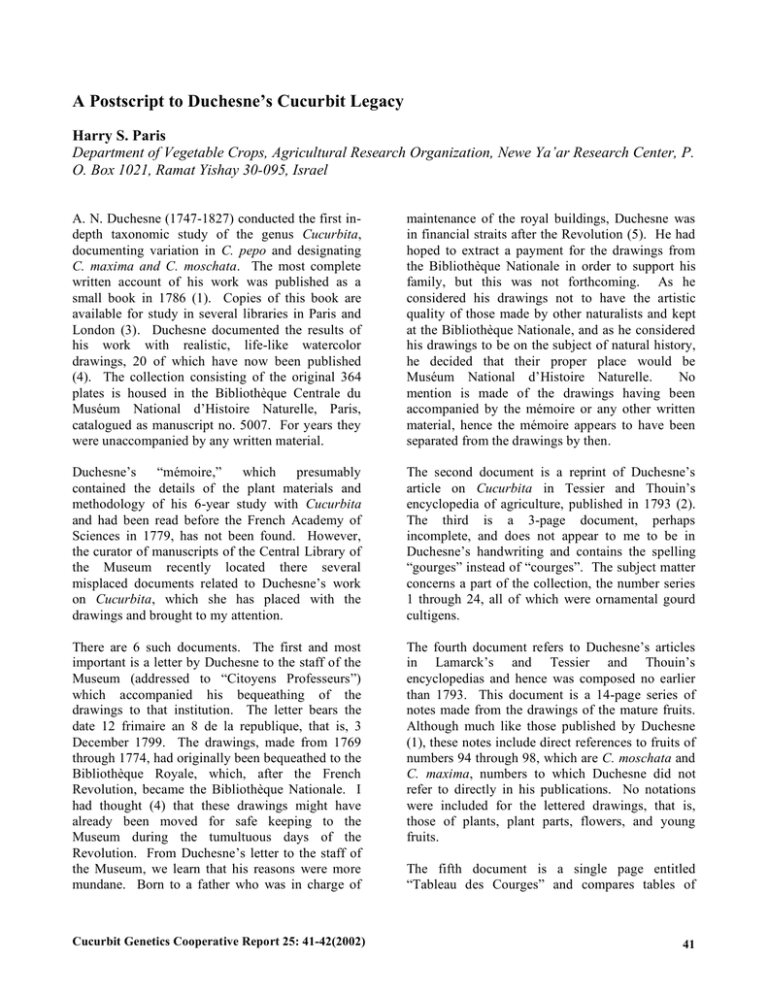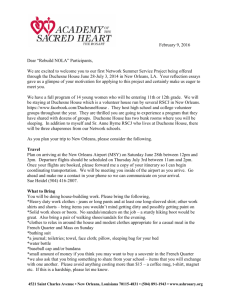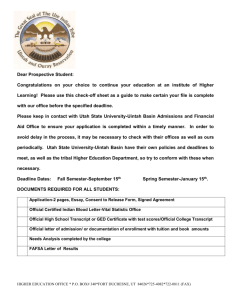A Postscript to Duchesne’s Cucurbit Legacy
advertisement

A Postscript to Duchesne’s Cucurbit Legacy Harry S. Paris Department of Vegetable Crops, Agricultural Research Organization, Newe Ya’ar Research Center, P. O. Box 1021, Ramat Yishay 30-095, Israel A. N. Duchesne (1747-1827) conducted the first indepth taxonomic study of the genus Cucurbita, documenting variation in C. pepo and designating C. maxima and C. moschata. The most complete written account of his work was published as a small book in 1786 (1). Copies of this book are available for study in several libraries in Paris and London (3). Duchesne documented the results of his work with realistic, life-like watercolor drawings, 20 of which have now been published (4). The collection consisting of the original 364 plates is housed in the Bibliothèque Centrale du Muséum National d’Histoire Naturelle, Paris, catalogued as manuscript no. 5007. For years they were unaccompanied by any written material. maintenance of the royal buildings, Duchesne was in financial straits after the Revolution (5). He had hoped to extract a payment for the drawings from the Bibliothèque Nationale in order to support his family, but this was not forthcoming. As he considered his drawings not to have the artistic quality of those made by other naturalists and kept at the Bibliothèque Nationale, and as he considered his drawings to be on the subject of natural history, he decided that their proper place would be Muséum National d’Histoire Naturelle. No mention is made of the drawings having been accompanied by the mémoire or any other written material, hence the mémoire appears to have been separated from the drawings by then. Duchesne’s “mémoire,” which presumably contained the details of the plant materials and methodology of his 6-year study with Cucurbita and had been read before the French Academy of Sciences in 1779, has not been found. However, the curator of manuscripts of the Central Library of the Museum recently located there several misplaced documents related to Duchesne’s work on Cucurbita, which she has placed with the drawings and brought to my attention. The second document is a reprint of Duchesne’s article on Cucurbita in Tessier and Thouin’s encyclopedia of agriculture, published in 1793 (2). The third is a 3-page document, perhaps incomplete, and does not appear to me to be in Duchesne’s handwriting and contains the spelling “gourges” instead of “courges”. The subject matter concerns a part of the collection, the number series 1 through 24, all of which were ornamental gourd cultigens. There are 6 such documents. The first and most important is a letter by Duchesne to the staff of the Museum (addressed to “Citoyens Professeurs”) which accompanied his bequeathing of the drawings to that institution. The letter bears the date 12 frimaire an 8 de la republique, that is, 3 December 1799. The drawings, made from 1769 through 1774, had originally been bequeathed to the Bibliothèque Royale, which, after the French Revolution, became the Bibliothèque Nationale. I had thought (4) that these drawings might have already been moved for safe keeping to the Museum during the tumultuous days of the Revolution. From Duchesne’s letter to the staff of the Museum, we learn that his reasons were more mundane. Born to a father who was in charge of The fourth document refers to Duchesne’s articles in Lamarck’s and Tessier and Thouin’s encyclopedias and hence was composed no earlier than 1793. This document is a 14-page series of notes made from the drawings of the mature fruits. Although much like those published by Duchesne (1), these notes include direct references to fruits of numbers 94 through 98, which are C. moschata and C. maxima, numbers to which Duchesne did not refer to directly in his publications. No notations were included for the lettered drawings, that is, those of plants, plant parts, flowers, and young fruits. Cucurbit Genetics Cooperative Report 25: 41-42(2002) The fifth document is a single page entitled “Tableau des Courges” and compares tables of 41 classification presented in Duchense’s works until 1793. The comparisons are not always, correct, however, as a table with Latin species epithets is presented as from Duchesne’s mémoire of 1779 but could not be from then (3) but is actually that published in his book of 1786 (1). The sixth document consists of four pages and is entitled “Travail des Pépons cultivés et peints par Ant. Nic. Duchesne”. This is a complete list of all of the drawings, numbered (mature fruits) and lettered (young fruits, flowers, plants and plant parts), contained in the collection. Among the listings is a plate, bearing the letter X, of six drawings made by Lucette Duchesne in 1796. No. Literature Cited 1. Duchesne, A.N. 1786. Essai sur l’histoire naturelles des courges. Panckoucke, Paris, 46 pp. 2. Duchesne, A.N. 1793. Courge, Cucurbita, in A.H. Tessier and A. Thouin (eds.), Encyclopédie Méthodique, Agriculture 3: 605-614. Panckoucke, Paris. Cucurbit Genetics Cooperative Report 25: 41-42(2002) 48 is not listed and, as I noted elsewhere (4), there is no drawing no. 48 in the collection even though this number had descendants through crosspollination. I thank Mme. Pascale Heurtel, Conservatrice des Manuscrits, Bibliothèque Centrale du Muséum National d’Histoire Naturelle, Paris, France, for notifying me of the finding these documents and for her dedicated assistance. Acknowledgements. Contribution No. 111/2002 from the Institute of Field & Garden Crops, Agricultural Research Organization, Bet Dagan, Israel. 3. Paris, H.S. 2000. First two publications by Duchesne of Cucurbita moschata (Cucurbitaceae). Taxon 49: 305-319. 4. Paris, H.S. 2000. Paintings (1769-1774) by A. N. Duchesne and the history of Cucurbita pepo. Ann. Bot. 85: 815-830. 5. Sylvestre, A.F. de. 1827. Notice biographique sur M. Ant.-Nicolas Duchesne. Huzard, Paris, 26 pp. 42


